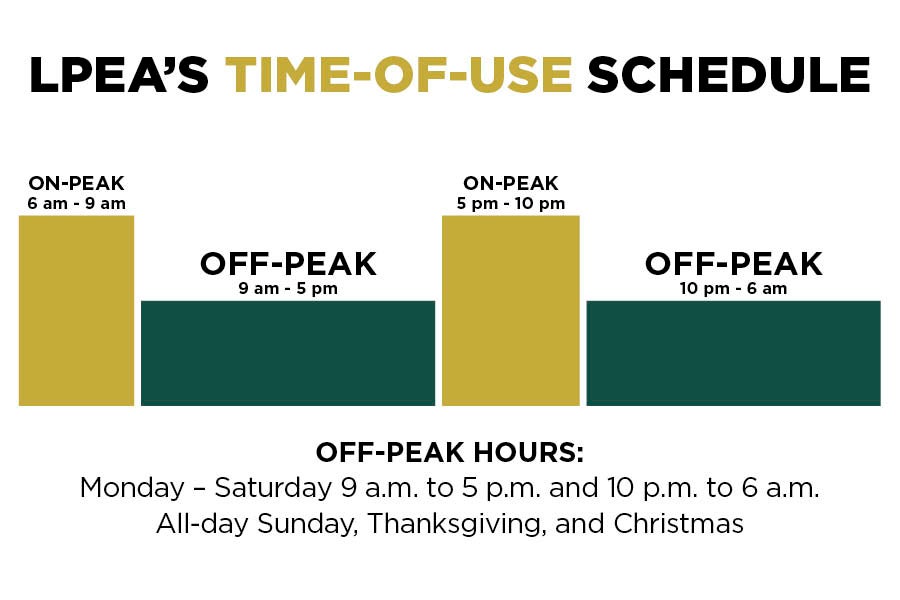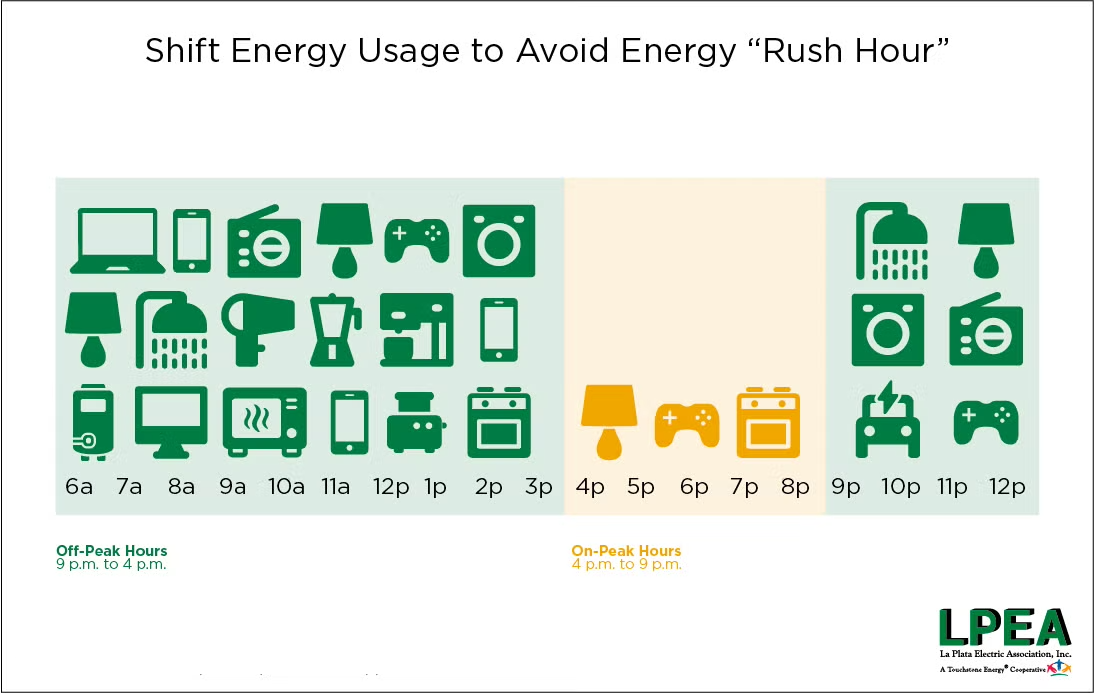2026 Rates
We are proud to announce that LPEA is protecting your rates heading into 2026, despite Tri-State's upcoming rate increase, rising costs, and inflation.
It is our mission to provide our members safe, reliable electricity at the lowest reasonable cost, and the LPEA Board of Directors has planned ahead to ensure we continue to live this mission.
As we complete our withdrawal from Tri-State in the spring of 2026, LPEA looks forward to the ability to make our own energy choices with affordability, reliability, and local and regional power sources top of mind.
On December 17th, the LPEA Board voted to approve the two new rate items outlined in the proposed rate modification document, linked here. These modifications include an update to the terms (but not the cost) of the opt-in renewable rider (item R18) and a new rate, pertaining to power generated in our service territory for delivery outside of our service territory using our transmission lines. (item W70).
| 2025/2026 | |
| Base Charge | $25.30 / month |
| Peak Charge (4 PM - 9 PM) | $5.73 / kW / month |
| Energy Charge per kWh | $0.1156 / kWh |
Rate Schedule: A-10
Rate Description (on your bill): General Service
Standard rate for single phase home, farm, and business use.
Peak charge is based on the single highest hourly kilowatt load used by the member between the hours of 4 PM and 9 PM each month.
| 2025/2026 | |
| Base Charge | $25.30 / month |
| Demand-Charge | $11.68 / kW / month |
| Energy Charge per kWh | $0.0970 / kWh |
Rate Schedule: GSD-10
Rate Description (on your bill): Large Single Phase
A single-phase home, farm, and business use requires over 50 kW of capacity.
Demand charge is based on the member’s once-per-month highest kilowatt hour over an entire billing cycle to accommodate the member’s individual electrical needs at any given time.
| 2025/2026 | |
| Base Charge | $25.30 / month |
| On-Peak Charge (per kWh) | $0.2828 / kWh |
| Off-Peak Charge (per kWh) | $0.0690 / kWh |
Rate Schedule: RTOU-15
Rate Description (on your bill): Residential Time-of-Use (General Service Time-of-Use)

To decrease this peak demand, LPEA’s optional Time-of-Use rate charges members different rates for their power based on the time of use. Off-Peak hours from 10 PM to 6 AM and 9 AM to 5 PM. Also, all day Sunday, Thanksgiving Day and Christmas Day.
Jump To A Section
Commercial Rates
- Small Commercial
- Small Commercial Three Phase
- Small Commercial Demand
- Small Commercial Time-of-Use
- Large Commercial
- Three Phase Time-Of-Use (TOU)
- Three Phase EV Time-Of-Use (TOU)
- Primary Service
- Snowmaking
- Transmission Coincident Peak
- Irrigation
- Sale for Resale
- Street Lighting
- Pole Attachments
- Dark Fiber Lease Rate
- Wheeling Service Fee
| 2025/2026 | |
| Base Charge | $25.30 / month |
| Peak Charge (4 PM - 9 PM) | $5.73 / kW / month |
| Energy Charge per kWh | $0.1156 / kWh |
Rate Schedule: 20
Rate Description (on your bill): Small Commercial Single Phase
Standard rate for single phase home, farm, and business use.
Peak charge is based on the single highest hourly kilowatt load used by the member between the hours of 4 PM and 9 PM each month.
| 2025/2026 | |
| Base Charge | $55 / month |
| Demand Charge | $6.23 / kW / month |
| Energy Charge per kWh | $0.1050 / kWh |
Rate Schedule: B2-21
Rate Description (on your bill): Small Commercial Three Phase (General Service Three Phase)
A larger meter for commercial purposes, typically for anticipated higher demand than a smaller meter serving the business property location. Meters are sized according to the electrical needs of the individual businesses at specific locations and can be upgraded or downgraded for a cost. R
| 2025/2026 | |
| Base Charge | $25.30 / month |
| Demand Charge | $11.68 / kW / month |
| Energy Charge per kWh | $0.0970 / kWh |
Rate Schedule: 20D
Rate Description (on your bill): Small Commercial Single Phase Demand
A single-phase home, farm, and business use requires over 50 kW of capacity.
Demand charge is based on the member’s once-per-month highest kilowatt hour over an entire billing cycle to accommodate the member’s individual electrical needs at any given time.
| 2025/2026 | |
| Base Charge | $25.30 / month |
| On-Peak Charge (per kWh) | $0.2828 / kWh |
| Off-Peak Charge (per kWh) | $0.0690 / kWh |
Rate Schedule: CTOU-24
Rate Description (on your bill): Small Commercial Time-of-Use
To decrease this peak demand, LPEA’s optional Time-of-Use rate charges members different rates for their power based on the time of use. On-Peak hours are 2 PM to 8 PM Monday through Saturday. Off-Peak hours are 8 PM to 2 PM Monday through Saturday, and all day Sundays, Thanksgiving, and Christmas.
| 2025/2026 | |
| Base Charge | $100 / month |
| Demand Charge | $18.34 / kW / month |
| Energy Charge per kWh | $0.0700 / kWh |
Rate Schedule: LP-30
Rate Description (on your bill): Large Commercial (Large General Service)
Three-phase service for large commercial accounts to meet electrical load power requirements.
| 2025/2026 | |
| Base Charge | $55 / month |
| Demand Charge | $7.71 / kW / month |
| On-Peak Charge (per kWh) | $0.2345 / kWh |
| Off-Peak Charge (per kWh) | $0.0650 / kWh |
Rate Schedule: B5-28
Rate Description (on your bill): Three Phase Time-of-Use
A larger, 3-phase meter on Time-of-Use rates. On-Peak hours are 2 p.m. to 8 p.m. Monday through Saturday. Off-Peak hours are 8 p.m. to 2 p.m. Monday through Saturday, and all day Sundays, Thanksgiving, and Christmas.
| 2025/2026 | |
| Base Charge | $150 / month |
| On-Peak Charge (per kWh) | $0.2828 / kWh |
| Off-Peak Charge (per kWh) | $0.0650 / kWh |
Rate Schedule: EV-28
Rate Description (on your bill): Three-Phase EV Time-of-Use
| 2025/2026 | |
| Base Charge | $1,300 / month |
| Demand Charge | $7.18 / kWh / month |
| On-Peak Charge (per kWh) | $0.1100 / kWh |
| Off-Peak Charge (per kWh) | $0.0600 / kWh |
Rate Schedule: LP-31
Rate Description (on your bill): Primary Service (Commercial Large Primary service)
Standard rate for commercial and industrial customers greater than 50 kVA and 50 kW who take service directly from an LPEA substation at a primary distribution voltage level.
| 2025/2026 | |
| Base Charge | $11,420 / month |
| On-Peak Charge (per kWh) | $0.1264 / kWh |
| Off-Peak Charge (per kWh) | $0.0690 / kWh |
Rate Schedule: SM-34
Rate Description (on your bill): Snowmaking (Snowmaking Time-of-Use)
A custom electric rate for our ski resorts allows a more cost-effective operation choice when manufacturing snow. Off-Peak hours from 10 p.m. to 6 a.m. and 9 a.m. to 5 p.m. Also, all day Sunday, Thanksgiving Day, and Christmas Day.
| 2025/2026 | |
| Base Charge | $1,300 / month |
| Coincident Demand per KW per month | $27.38 / kW / month |
| Energy Charge (per kWh) | $0.0445 / kWh |
Rate Schedule: TCP-36
Rate Description (on your bill): Transmission Coincident Peak
Optional rate for industrial customers greater than 10 MW who take service directly from LPEA transmission facilities at standard transmission voltage.
| 2025/2026 | |
| Demand | $19.74 / kW / month |
| Energy Charge per kWh | $0.135 / kWh |
Rate Schedule: C-40
Rate Description (on your bill): Irrigation
The energy costs needed to supply the appropriate amount of horsepower required to pump water throughout the growing season.
| 2025/2026 | |
| Base Charge | $200 / month |
| Demand | $10.00 / kW / month |
| Energy Charge (per kWh) | $0.1311 / kWh |
Rate Schedule: SR-41
Rate Description (on your bill): Sale for Resale
The sale of solar energy produced, generated, and consumed between a member and utility provider.
| 2025/2026 | |
| Service Light (Approx. 5,200 Lumens): | $12.57 / month |
| Small Light (Approx. 5,800 Lumens): | $14.84 / month |
| Medium Light (Approx. 9,000 Lumens): | $23.38 / month |
| Large Light (Approx. 12,000 Lumens): | $32.33 / month |
Rate Schedule: SL-50
Rate Description (on your bill): Street Lighting (Street and Security Area Lighting)
Rate charge for the rental and electricity usage of a street or security or lights.
| 2025/2026 | |
| Pole Attachment Rate (Per attachment, per year) |
$16.79 |
| 2025/2026 | |
| Dark Fiber Lease Rate (Per fiber, per mile, per year) |
$546.36 |
| 2026 | |
| Wheeling Charge (per/kW of Nameplate Capacity per month |
$2.18 |
Schedule: W70
Wheeling is the use of the Association’s transmission and/or distribution facilities to transmit generated power within the Association’s service territory to a point of connection on the wholesale power grid.

If you still need help understanding your rates, check out our bill explainer here and reach out to our member services team at memberservices@lpea.coop or call 970-247-5786.
Types of Charges
Peak Power
The Peak Power charge is based on the single, highest hourly kilowatt load used by the member between the hours of 4:00 pm - 9:00 pm each month.
Please note that the Peak Power charge does not apply to Time Of Use members and that the hours differ.

Base Charge
LPEA separates the base charge line item from the energy charges for transparency and to give members more control over their usage.
What does this charge cover?
This is the minimal amount required to have active service.
How is it calculated?
This is determined based on the amount of infrastructure and services needed to deliver the required power from our power provider (Tri-State) to the members in each rate class.
Energy Charge
What does this charge cover?
The base cost per kilowatt hour.
How is it calculated?
This is based on what Tri-State charges LPEA to deliver electricity to the membership
Demand Charge
What does this charge cover?
Charge based on your meter size and type, usually larger meters with more demand requirements than an average residential meter.
How is it calculated?
This charge is based on the member’s once-per-month highest kilowatt hour over an entire billing cycle to accommodate the member’s individual electrical needs at any given time.
Frequently Asked Questions
We understand the confusion around the word choice of tariff vs rate. Please note the following definitions as they relate to electric "rates" vs "tariffs":.
- "Rate" - typically refers to the specific price per unit of electricity that users are charged. These are the figures members see on their bills that indicate how much is paid for energy consumed.
- "Tariff" - is an industry term and refers to the comprehensive documents or schedules that outline the complete pricing structure for electricity. Our proposed "tariff" includes not only the rates (price per kilowatt hour) but also outlines additional charges (such as base charge, demand charge, facility charge etc.), fees, and terms and conditions under which service is provided.
You may also review Policy 364 here for a more formal discussion of "tariffs" as they relate to our cooperative governance.
Yes. Our friendly and knowledgeable Member Service Representatives are available Monday through Thursday to help you understand your electric bill and find new ways to save on your energy costs.
Call them at: 970-247-5786
Email them at: memberservices@lpea.coop
There are a number of ways members can participate.
- Attend our monthly Board Meetings
- Contact your directors
- Run for a seat on the board. The deadline to apply is March 22, 2025. Learn more here.
- Vote for your Board representatives. Elections will begin with online and mail-in voting in mid-April, and in-person voting and election results announced May 21 at the annual meeting.
Yes. Rates are remaining the same in 2026.
The Board and LPEA have planned ahead to ensure financial stability for the membership.
- In 2022, the LPEA Board created a Rate Stabilization Fund, reserving the margins from stronger financial years to prepare for future uncertainties, like inflation and Tri-State's 7.5% rate increase.
- The Board and LPEA staff have also continually prioritized disciplined financial stewardship over the years, as reflected in the recent A+ credit rating from Fitch.
- The Board and LPEA leadership negotiated agreements for reliable, cost-effective electricity for LPEA members through the 2026–2028 bridge period, giving the cooperative a diversified and flexible power portfolio and lower the blended cost of power by more than 10 percent starting in 2026—compared to current wholesale rates.
This foresight has allowed us to keep rates stable and to continue investing in the reliability of our system without compromising financial health.
Currently, this line item (R18) is paid by members who have opted in to purchase renewable energy credits (RECs), and it is passed through to Tri-State. If the changes are adopted, the funds will simply cease to be passed through to Tri-State, and will instead be used by LPEA to purchase Renewable Energy Credits on behalf of participating members.
Any excess funds collected from this rider will be added to the Local Energy Action Fund, which is used to invest in local renewable energy projects.
The Wheeling Service Fee (W70) pertains to power generated in our service territory for delivery outside our service territory using our transmission lines. These funds will be used to maintain our grid and transmission assets, so all members will benefit.
Questions and Comments
There are no items open for public comment at this time.
